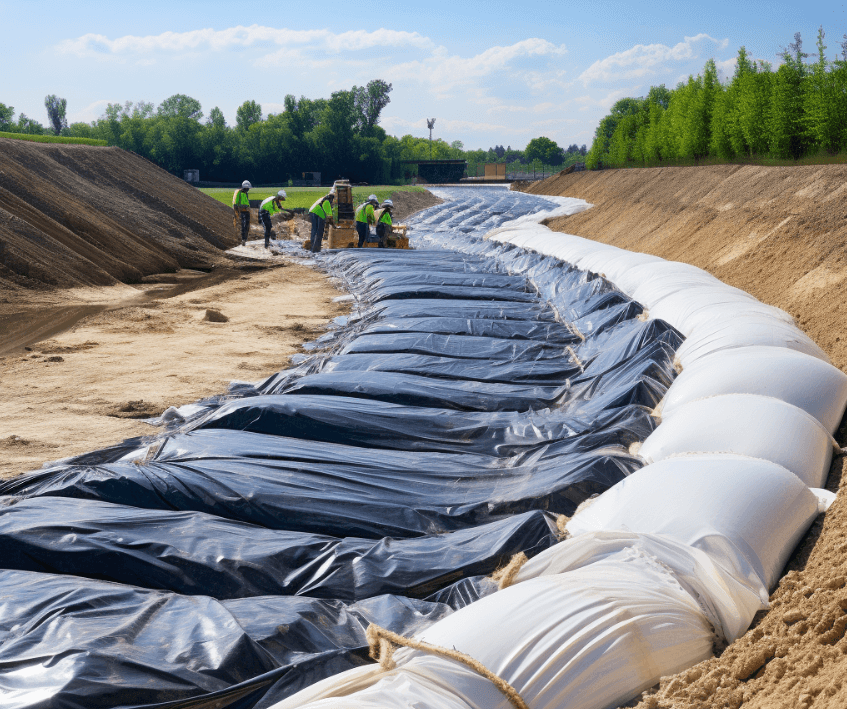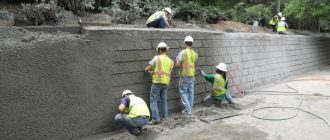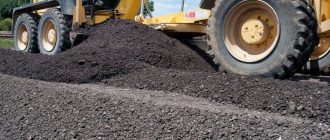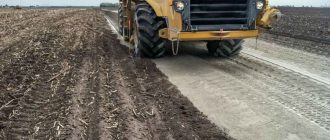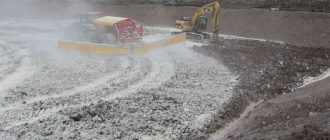
What is Meant by Soil Stabilization?
Soil stabilization is a process that involves improving the properties of soil to make it more suitable for construction purposes. The stability of soil plays a crucial role in the success of any construction project, as it directly affects the safety and durability of the structure. By stabilizing the soil, engineers can ensure that it can withstand the weight and pressure of the building, preventing issues such as soil settlement and structural failure.
But what exactly is soil stabilization? It is the process of altering or enhancing the engineering properties of soil to improve its strength, durability, and overall performance. This can be done through various techniques, such as mixing additives like cement, lime, or fly ash into the soil or injecting chemicals to bind the particles together. The goal is to create a stable and reliable foundation that can support the weight of the structure and resist external forces.
Soil stabilization is particularly important in areas with poor soil conditions, such as loose or weak soils, expansive clay, or areas prone to erosion. Without proper stabilization, the soil may settle over time, leading to uneven surfaces, cracks in the structure, or even collapse. By implementing soil stabilization techniques, engineers can mitigate these risks and ensure the long-term stability and safety of the construction project.
In conclusion, soil stabilization is a vital aspect of construction projects, as it ensures the safety and durability of the structure. Through various techniques and additives, engineers can improve the strength and performance of the soil, making it suitable for building. Understanding the concept of soil stabilization is crucial for any construction professional, as it allows them to design and implement measures that will prevent issues such as settlement and structural failure.
Importance of Soil Stabilization in Construction
Soil stabilization is a crucial process in construction that involves improving the properties of soil to make it more suitable for building structures. It is done by modifying and enhancing the physical and chemical characteristics of the soil to increase its strength, stability, and durability.
Stabilization of soil is necessary because not all soils have the ideal properties needed for construction. Some soils may be too weak or unstable, which can lead to foundation settlement, structural failures, and other problems.
By stabilizing the soil, construction projects can ensure a solid and stable foundation, preventing issues such as sinking, shifting, or cracking of structures. It also reduces the risk of soil erosion, which can cause damage to the environment and nearby water bodies.
Benefits of Soil Stabilization in Construction:
- Increased strength: Stabilization improves the load-bearing capacity of soil, allowing it to support heavy structures such as buildings, roads, and bridges.
- Better durability: Stabilized soil is more resistant to wear and tear, weathering, and other environmental factors, ensuring the longevity of constructed structures.
- Improved stability: Stabilization prevents soil settlement, subsidence, and shifting, ensuring the stability of the entire construction.
- Reduced construction time and cost: By stabilizing the soil, construction projects can reduce the need for excessive excavation, additional materials, and complex foundation systems, saving time and cost.
There are various methods of soil stabilization that can be used depending on the specific requirements of the project. These methods include mechanical stabilization, chemical stabilization, and stabilization through the addition of additives or binders. The choice of method depends on factors such as soil type, project scope, budget, and time constraints.
In conclusion, soil stabilization plays a vital role in construction by ensuring the stability, strength, and durability of structures. It is a necessary process to overcome the limitations of natural soil and to create a solid foundation for safe and reliable construction.
Types of Soil Stabilization Methods
Soil stabilization is achieved through various methods that are aimed at improving the properties of soil for construction purposes. The choice of method depends on factors such as the type of soil, desired end result, and cost.
- Chemical Stabilization: This method involves the use of various chemicals to enhance the soil’s engineering properties. Common chemicals used for soil stabilization include lime, cement, and fly ash. These chemicals react with the soil particles to increase its strength and stability.
- Mechanical Stabilization: Mechanical stabilization is achieved by altering the physical characteristics of the soil. This can be done through methods such as compaction, which increases the density of the soil particles and reduces its susceptibility to erosion or settlement.
- Biological Stabilization: In this method, natural materials are used to stabilize the soil. For example, the roots of vegetation can help to bind the soil particles together, reducing erosion. Bioengineered techniques, such as the use of geotextiles or soil reinforcement techniques, can also be employed for stabilization purposes.
- Electrochemical Stabilization: Electrochemical stabilization involves the use of electrical currents or electrochemical processes to improve the soil’s stability. This method is commonly used in situations where the soil contains contaminants that need to be remediated.
Each of these soil stabilization methods has its own advantages and limitations, and the best approach often depends on the specific project requirements. It is important to consult with soil stabilization experts to determine the most appropriate method for a given situation.
Understanding the Soil Stabilization Process
When it comes to construction projects, one important aspect that needs to be considered is the stability of the soil. Soil stabilization is the process of improving the properties of the soil to make it more suitable for construction purposes. But what exactly is meant by soil stabilization?
Soil stabilization is the process of altering the physical, chemical, and mechanical properties of the soil to improve its strength, durability, and load-bearing capacity. It involves various techniques and materials to enhance the soil’s performance and make it stable enough to support the structures built on it.
The process of soil stabilization can be achieved through different methods, including mechanical techniques, chemical additives, and natural materials. The choice of method depends on the type and condition of the soil, as well as the desired outcome.
Mechanical techniques for soil stabilization involve the use of different equipment to alter the properties of the soil. This may include compaction, which involves reducing the air voids in the soil particles to increase its density and strength. Other methods may include soil mixing, where soil and additives are combined to improve stability, or soil reinforcement, where materials like geotextiles or geogrids are used to enhance the soil’s strength and resistance to deformation.
Chemical additives can also be used to stabilize the soil. These additives can include cement, lime, or fly ash, which are mixed with the soil to improve its cohesion and strength. The chemical reaction between the additives and the soil particles helps bind them together, creating a more stable soil structure.
In some cases, natural materials can also be used for soil stabilization. This may include using organic materials like straw or sawdust to improve the soil’s moisture retention and stability. Other natural methods may include the use of vegetation, such as grass or trees, to help stabilize the soil by reducing erosion and providing root reinforcement.
Overall, the soil stabilization process is essential in construction projects to ensure the stability and durability of the structures built on the soil. It involves various techniques and materials to improve the soil’s properties and make it suitable for construction purposes. By understanding the soil stabilization process, engineers and construction professionals can successfully assess and address soil stability issues in their projects.
Key Factors Affecting Soil Stabilization
Soil stabilization is the process of improving the properties of soil to enhance its strength and durability. It involves various techniques and factors that are crucial for achieving the desired results. Understanding these key factors is essential for successful soil stabilization projects. Here are some of the important factors that affect soil stabilization:
- Soil Type: The type of soil plays a significant role in determining the appropriate stabilization technique. Different soil types have different properties, such as particle size, composition, and moisture content, which affect the effectiveness of stabilization methods.
- Moisture Content: The moisture content of the soil is another important factor. The optimal moisture content for stabilization depends on the specific technique used. Excess moisture can lead to reduced strength, while insufficient moisture can hinder the binding of soil particles.
- Additives: Additives, such as lime, cement, and fly ash, are often used to enhance the stabilizing properties of soil. These additives help in modifying the soil structure and improving its stability. The type and amount of additives used depend on the soil type and the desired outcome.
- Compaction: Proper compaction is vital for achieving effective soil stabilization. It involves the application of mechanical force to the soil in order to reduce its volume and increase its density. Compaction helps in improving the load-bearing capacity and reducing settlement of the stabilized soil.
- Environmental Conditions: Environmental conditions, such as temperature and rainfall, can affect the effectiveness of soil stabilization. Extreme temperatures and heavy rainfall can cause the soil to expand or contract, leading to potential damage. It is important to consider these factors during the stabilization process.
- Quality Control: Effective quality control measures are crucial for ensuring successful soil stabilization. These include proper testing and monitoring of soil properties, additives, and compaction levels. Regular inspections and evaluations help in identifying any issues or deviations and allow for necessary adjustments to be made.
By considering these key factors, engineers and construction professionals can make informed decisions and implement appropriate techniques for soil stabilization projects. Understanding the characteristics and behavior of soil, as well as the impact of various factors, is essential for achieving long-lasting and reliable stabilization results.
Advantages of Soil Stabilization in Infrastructure Projects
Soil stabilization is meant to enhance the engineering properties of soil by improving its strength, stability, and durability. This process is crucial in infrastructure projects where the stability of the ground is paramount. Here are some advantages of soil stabilization in infrastructure projects:
- Improved load-bearing capacity: Soil stabilization increases the load-bearing capacity of the soil, allowing it to support heavier structures and traffic loads. This is especially important in the construction of roads, highways, and bridges.
- Reduced soil settlement: Stabilized soil experiences less settlement over time, minimizing the risk of structural damage and uneven settling. This contributes to the longevity and stability of the infrastructure.
- Enhanced erosion control: Stabilized soil is more resistant to erosion caused by water, wind, or other natural forces. This helps to maintain the integrity of slopes, embankments, and other earthworks within the infrastructure project.
- Improved soil cohesion: Soil stabilization increases the cohesion of the soil particles, making it more resistant to shearing, slippage, and instability. This is crucial in areas prone to landslides or unstable slopes.
- Reduced construction time: By stabilizing the soil, the construction process can be expedited, as there is less time spent on extensive earthwork preparations. This leads to cost savings and faster project completion.
In conclusion, soil stabilization is a vital component of infrastructure projects as it enhances the performance and durability of the underlying soil. The advantages of soil stabilization include improved load-bearing capacity, reduced soil settlement, enhanced erosion control, improved soil cohesion, and reduced construction time. By incorporating soil stabilization techniques, engineers can ensure the long-term stability and safety of infrastructure projects.
Environmental Benefits of Soil Stabilization
Soil stabilization refers to the process of improving the physical properties of soil to enhance its strength, durability, and stability. But what does it mean for the environment?
When soil is stabilized, it helps prevent erosion and sedimentation. This is particularly important in areas where construction activities or natural factors like heavy rainfall can cause soil erosion. By stabilizing the soil, we can minimize the loss of fertile topsoil and prevent it from being carried away by wind or rain into nearby water bodies.
Stabilized soil also plays a crucial role in reducing water pollution. When unstable soil is eroded, it often carries pollutants such as pesticides, fertilizers, and other contaminants that have been spread on the ground. These pollutants can enter water bodies, affecting the quality of water and harming aquatic life. Soil stabilization helps prevent this pollution by keeping the soil in place and limiting the movement of contaminants.
Moreover, soil stabilization contributes to the preservation of natural resources. By reducing the erosion of soil, it helps preserve agricultural land, forests, and other natural habitats. This is vital for maintaining biodiversity and protecting the ecosystem.
The process also results in a decrease in the need for excavation and landfills. By stabilizing soil, construction projects can optimize the use of existing materials on-site, reducing the need for new materials and minimizing waste generation. This helps conserve resources and reduces the environmental impact associated with the transportation and disposal of waste materials.
Furthermore, soil stabilization supports sustainable development. It allows for the utilization of marginal or low-quality soils that would otherwise be unsuitable for construction purposes. By making these soils usable, soil stabilization reduces the need for acquiring new land, thus conserving natural landscapes and reducing urban sprawl.
In summary, soil stabilization has several environmental benefits. It helps prevent erosion and sedimentation, reduces water pollution, preserves natural resources, decreases waste generation, and promotes sustainable development. By recognizing and implementing soil stabilization techniques, we can contribute to the protection of the environment and create a more sustainable future.
Comparison of Traditional and Modern Soil Stabilization Techniques
Soil stabilization, often referred to as soil treatment, is a method used to improve the engineering properties of soil in order to make it more stable and suitable for construction. It involves the addition of certain materials to the soil to enhance its strength, durability, and load-bearing capacity.
Traditional soil stabilization techniques have been used for centuries and generally involve the use of natural materials, such as lime, cement, or bitumen, to bind the soil particles together. These techniques often require a significant amount of resources and time to implement, as they involve extensive excavation and the transportation of large amounts of materials to the construction site.
Modern soil stabilization techniques, on the other hand, utilize advanced materials and technologies to achieve the same goal more efficiently and effectively. These techniques often involve the use of specialized additives, such as polymers, enzymes, or geosynthetics, which can be applied directly to the soil without the need for extensive excavation.
Advantages of Modern Soil Stabilization Techniques:
- Time-saving: Modern techniques are generally faster to implement compared to traditional techniques, as they eliminate the need for extensive excavation and transportation of materials.
- Cost-effective: Modern techniques often require less material and labor, resulting in cost savings for construction projects.
- Environmentally-friendly: Modern techniques can reduce the environmental impact of soil stabilization projects by minimizing excavation and material transportation.
- Improved performance: Modern techniques can provide superior soil stabilization results, as they often utilize advanced materials that offer enhanced strength, durability, and load-bearing capacity.
Disadvantages of Modern Soil Stabilization Techniques:
- Higher initial cost: The advanced materials and technologies used in modern techniques may result in higher initial costs compared to traditional techniques.
- Dependency on technology: Modern techniques may require specialized equipment and expertise, which could be a challenge in some regions or for smaller projects.
- Limited long-term data: As modern techniques are relatively new, there may be limited long-term data available to assess their performance over an extended period of time.
In conclusion, soil stabilization refers to the process of improving the engineering properties of soil for construction purposes. Traditional techniques involve the use of natural materials and often require extensive excavation, while modern techniques utilize advanced materials and technologies to achieve the same goal more efficiently and effectively. Both approaches have their advantages and disadvantages, and the choice between them depends on project requirements, budget, and local conditions.
Common Soil Stabilizers Used in Construction
Soil stabilization is the process of improving the properties of soil in order to make it suitable for construction projects. This can involve various techniques and materials, including the use of soil stabilizers.
Soil stabilizers are substances that are added to the soil to enhance its strength, durability, and resistance to erosion. They work by altering the soil’s properties, such as its moisture content and particle size distribution, to create a more stable and compacted material.
There are several common types of soil stabilizers used in construction:
- Lime: Lime is a commonly used soil stabilizer due to its availability and effectiveness. It is typically added to clay soils to increase their strength and decrease their plasticity. Lime can also help reduce the swell and shrinkage properties of clay soils, making them more stable.
- Cement: Cement is another widely used soil stabilizer, especially for sandy or silty soils. It reacts with water to form a cementitious gel that binds the soil particles together, creating a stronger and more cohesive material. Cement stabilization is often used for road bases and foundations.
- Bitumen: Bitumen, also known as asphalt or tar, is a common soil stabilizer used for road construction. It serves as a binding agent, improving the strength and durability of the soil. Bitumen stabilization is often used for sandy or gravelly soils.
- Chemical Stabilizers: Chemical stabilizers, such as polymers and enzymes, are sometimes used to improve the properties of soil. These substances can modify the soil’s structure and enhance its stability. Chemical stabilization is often used for contaminated or problematic soils.
It’s worth noting that the choice of soil stabilizer depends on various factors, including the type of soil, project requirements, and environmental considerations. Soil testing and analysis are typically conducted to determine the most suitable stabilizer for a particular project.
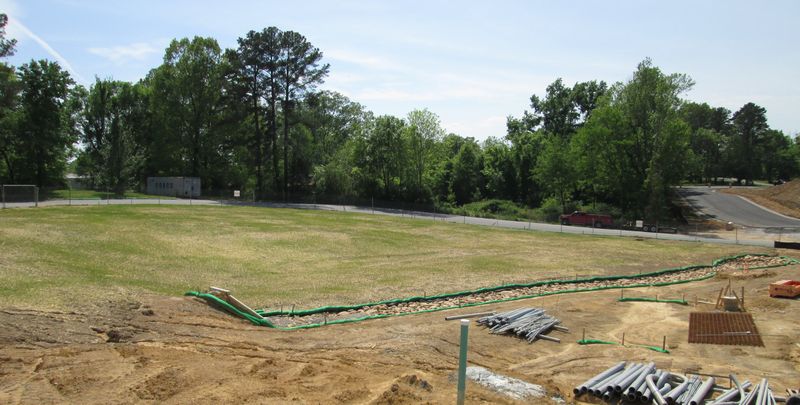 Comparison of Common Soil Stabilizers Stabilizer Advantages Disadvantages
Comparison of Common Soil Stabilizers Stabilizer Advantages Disadvantages
| Lime | Widely available Effective for clay soils Reduces plasticity of clay soils |
Not suitable for sandy soils Requires careful dosage control |
| Cement | Creates strong and cohesive material Effective for sandy or silty soils |
Requires curing time High carbon footprint |
| Bitumen | Binds soil particles together Used for road construction |
Not suitable for all soil types Temperature-sensitive |
| Chemical Stabilizers | Can modify soil structure Effective for contaminated soils |
May have environmental concerns Requires specific expertise |
Understanding the different soil stabilizers and their advantages and disadvantages is crucial for successful construction projects. It allows engineers and contractors to select the most appropriate stabilizer based on the specific soil conditions and project requirements.
Challenges and Limitations of Soil Stabilization
Soil stabilization is meant to improve the strength and durability of soil by adding certain materials or altering its properties. While this process has proven to be effective in many cases, it also comes with its own set of challenges and limitations.
One of the main challenges of soil stabilization is determining the appropriate technique or method to use for a specific soil type. Different soils have different characteristics and require different approaches for stabilization. This requires a thorough understanding of soil mechanics and the ability to assess the soil’s properties accurately.
Another challenge is the availability of suitable stabilization materials. Certain additives, such as lime or cement, may not be readily available in some regions, making it challenging to implement certain stabilization techniques. This limitation can be overcome by exploring alternative materials or utilizing local resources.
Furthermore, the effectiveness of soil stabilization can be influenced by environmental factors such as temperature and moisture. High temperatures can accelerate the curing process of stabilization materials, while excessive moisture can hinder their effectiveness. It is important to consider these factors and adjust the stabilization process accordingly.
Additionally, the long-term performance of stabilized soil can be a limitation. Over time, the effectiveness of stabilization materials may deteriorate due to various factors such as erosion, weathering, or traffic load. Regular maintenance and monitoring are necessary to ensure the continued stability of the soil.
Lastly, the cost of soil stabilization can be a limitation for some projects. Depending on the specific technique and materials used, soil stabilization can be a costly process. It is important to carefully evaluate the cost-benefit analysis and consider alternative solutions if the budget is a constraint.
Conclusion
While soil stabilization is a valuable technique for improving the strength and durability of soil, it is not without its challenges and limitations. The proper selection of stabilization techniques, availability of suitable materials, environmental factors, long-term performance, and cost considerations all play a role in the successful implementation of soil stabilization projects. Understanding these challenges and limitations is crucial for achieving optimal results.
Case Studies: Successful Applications of Soil Stabilization
Soil stabilization is a widely used method in construction and engineering projects to enhance the strength and durability of soil. By stabilizing the soil, it becomes more resistant to erosion, settlement, and other unfavorable conditions.
There have been numerous successful applications of soil stabilization in various projects. Some of these case studies are highlighted below:
- Road Construction:In road construction projects, soil stabilization is often used to improve the properties of the subgrade soil. By treating the soil with stabilizers such as lime, cement, or chemical additives, the soil’s load-bearing capacity and resistance to moisture can be significantly enhanced. This leads to stronger and more durable roads that can withstand heavy traffic and adverse weather conditions.
- Embankment Construction:Embankments are often constructed to form slopes or to provide support for infrastructure projects like highways, railways, and buildings. Soil stabilization is crucial in these cases to prevent slope failure and provide stability to the embankments. By reinforcing the soil through the incorporation of geosynthetic materials or stabilizing agents, embankments become more resistant to erosion, settlement, and deformation.
- Foundation Construction:Soil stabilization plays a vital role in foundation construction, particularly in areas with weak or expansive soils. By stabilizing the soil beneath the foundation using techniques like deep soil mixing or jet grouting, the soil’s bearing capacity can be improved. This ensures that the foundation remains stable and prevents settlement or heave due to soil movement.
- Erosion Control:Soil stabilization is an effective measure for erosion control. In projects involving slopes, riverbanks, or coastal areas where erosion is a concern, stabilizing the soil helps to prevent soil loss and maintain slope stability. Techniques like slope reinforcement, erosion control blankets, or vegetative stabilization can be used to stabilize the soil and protect it from erosion caused by wind or water.
- Mine Site Rehabilitation:Soil stabilization is often employed in mine site rehabilitation projects to restore the land and prevent environmental damage. By stabilizing the soil, the risk of erosion and contaminants leaching into the surrounding environment can be reduced. This promotes the growth of vegetation and restores the area to a more natural state.
These case studies demonstrate the extensive applications and benefits of soil stabilization in various construction and environmental projects. Whether it is for road construction, embankment stability, foundation support, erosion control, or mine site rehabilitation, soil stabilization is a versatile technique that enhances the performance and longevity of engineered structures.
Future Trends in Soil Stabilization Techniques
Soil stabilization techniques have evolved over the years to address the challenges posed by various soil types and conditions. In the future, advancements in technology and research are expected to bring about significant improvements in these techniques. Here are some of the future trends that can be expected in soil stabilization:
- Innovative Materials: Research is being conducted to develop and test new materials that can enhance the stabilization process. These materials may include biopolymers, nanocomposites, and advanced chemicals.
- Sustainable Approaches: With increasing concern for the environment, future trends in soil stabilization will focus on sustainable approaches. These may involve the use of recycled or organic materials, as well as techniques that minimize the use of chemicals and energy.
- Remote Monitoring: The use of remote monitoring technologies, such as sensors and IoT (Internet of Things) devices, will enable real-time monitoring of soil conditions. This will allow for proactive and timely interventions to maintain soil stability.
- Data-driven Decision Making: Advancements in data collection and analysis will play a crucial role in soil stabilization. By collecting and analyzing data on soil properties, performance, and environmental factors, engineers can make informed decisions regarding the most effective stabilization techniques.
- Integrated Approaches: Future trends will involve the integration of soil stabilization techniques with other construction processes. This integrated approach will ensure that stabilization is considered from the early stages of a project, leading to more efficient and cost-effective solutions.
- Automation and Robotics: The use of automation and robotics in soil stabilization will increase efficiency and accuracy. For example, automated mixing and application systems can ensure consistent and precise distribution of stabilizing agents.
Overall, the future of soil stabilization techniques looks promising with the potential for improved materials, sustainable approaches, advanced monitoring and data analysis, integrated strategies, and automation. These advancements will help in achieving stronger, more durable, and environmentally-friendly soil stabilization solutions.
International Standards and Guidelines for Soil Stabilization
Soil stabilization is an important process in construction and civil engineering projects, as it involves improving the properties of soil to enhance its strength, durability, and load-bearing capacity. To ensure that soil stabilization is carried out effectively and efficiently, international standards and guidelines have been established to provide a framework for the process.
These international standards and guidelines define the principles, methods, and requirements for soil stabilization, helping to ensure consistency and quality in the process. They outline the steps to be followed, the materials to be used, and the performance criteria to be met.
What is Soil Stabilization?
Soil stabilization is the process of altering the properties of soil to improve its engineering properties. It is meant to enhance the stability, strength, and durability of soil, making it suitable for construction purposes. Several methods are used for soil stabilization, including the use of additives such as cement, lime, and asphalt, as well as mechanical stabilization techniques.
International Standards and Guidelines for Soil Stabilization
The following are some of the international standards and guidelines that govern soil stabilization:
- ASTM D 1557: Standard Test Methods for Laboratory Compaction Characteristics of Soil Using Modified Effort (56,000 ft-lbf/ft3 (2,700 kN-m/m3))
- BS 1924: Stabilized Materials for Civil Engineering Purposes
- ISO 17892: Geotechnical Investigation and Testing – Laboratory Testing of Soil
- AASHTO T 180: Standard Method of Test for Moisture-Density Relations of Soils Using a 4.54-kg (10-lb) Rammer and a 457-mm (18-in.) Drop
These standards and guidelines cover various aspects of soil stabilization, including laboratory testing methods, compaction characteristics, and moisture-density relationships. They provide a basis for evaluating the effectiveness of soil stabilization techniques and ensuring the quality of the stabilized soil.
Benefits of Following International Standards and Guidelines
By following international standards and guidelines for soil stabilization, contractors and engineers can benefit in several ways:
- Ensuring consistency and quality in the soil stabilization process.
- Enhancing the strength, durability, and stability of the soil.
- Minimizing the risk of failures and structural damage.
- Improving the load-bearing capacity of the soil.
Overall, adherence to international standards and guidelines for soil stabilization plays a crucial role in achieving successful construction projects and ensuring the long-term stability and performance of the built infrastructure.
Q&A:
What is soil stabilization?
Soil stabilization refers to the process of improving the physical properties of soil in order to enhance its strength and durability. Various techniques are used to achieve soil stabilization, such as adding cement or lime to the soil, compacting it, or mixing it with other materials.
Why is soil stabilization important?
Soil stabilization is important because it helps to create a stable foundation for construction projects. By improving the properties of soil, it becomes more resistant to erosion, shrinkage, and swelling. This ensures that structures built on the stabilized soil have a longer lifespan and are less prone to damage.
What are the different methods of soil stabilization?
There are several methods of soil stabilization, including chemical stabilization, mechanical stabilization, and biological stabilization. Chemical stabilization involves the addition of additives like cement or lime to the soil.

Mechanical stabilization involves compacting the soil or adding reinforcement materials.
Biological stabilization involves using vegetation or microorganisms to improve soil properties.
Can soil stabilization be used for both new construction and existing structures?
Yes, soil stabilization can be used for both new construction projects and existing structures. For new construction, soil stabilization is typically done before the foundation is laid to provide a stable base. For existing structures, soil stabilization may be necessary if the soil underneath is unstable and causing damage to the structure.
What are the advantages of soil stabilization?
There are several advantages of soil stabilization. Firstly, it improves the load-bearing capacity of soil, allowing it to support heavier structures. Secondly, it reduces soil settlement, preventing the uneven settling of buildings or roads. Thirdly, it improves soil durability, making it more resistant to erosion and weathering. Lastly, it can also help to reduce construction costs by eliminating the need for extensive excavation or replacement of unstable soil.
What is soil stabilization?
Soil stabilization is the process of modifying and enhancing the properties of soil to improve its strength, durability, and resistance to erosion and other forms of degradation.
Why is soil stabilization important?
Soil stabilization is important because it helps to provide a stable foundation for structures such as roads, buildings, and embankments. It also helps to prevent soil erosion and other forms of degradation, which can be damaging to the environment.
